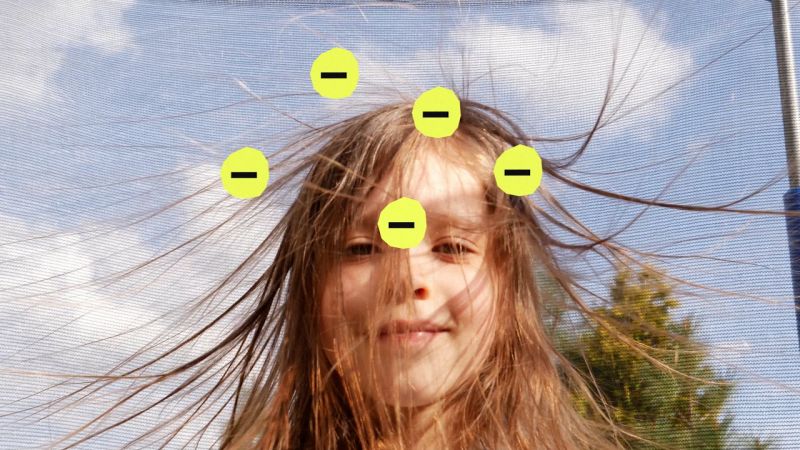Understanding Staticky Hair: A Scientific Explanation

Table of Contents
Understanding Staticky Hair: A Scientific Explanation
Hair standing on end, clinging to your clothes, attracting dust like a magnet—static electricity in your hair is a common annoyance. But what's actually happening? This article delves into the science behind static cling, offering solutions to tame those unruly strands.
The Root of the Problem: Triboelectric Effect
Static electricity in hair isn't some mysterious force; it's a consequence of the triboelectric effect. This effect describes the transfer of electrons between two materials when they come into contact and then separate. Hair, often dry and lacking moisture, is particularly susceptible. When you brush your hair, for example, the friction between the brush bristles and your hair strands causes electrons to move. Depending on the materials, one material (like your hair) may lose electrons and become positively charged, while the other (the brush) gains electrons and becomes negatively charged. This charge imbalance is what creates static electricity.
Different materials have different affinities for electrons. The triboelectric series is a ranking of materials based on their tendency to gain or lose electrons. Hair, especially dry hair, tends to be higher on the series, meaning it readily loses electrons to materials like plastic or nylon. This electron loss leaves the hair positively charged, causing individual strands to repel each other, resulting in that familiar "flyaway" effect.
Environmental Factors:
Humidity plays a significant role. In dry environments (low humidity), electrons are less likely to dissipate into the air, allowing static charges to build up more readily. This is why static hair is often a winter problem in colder climates with lower humidity levels.
Synthetic fabrics are another common culprit. Materials like polyester and nylon, frequently used in clothing, are prone to accumulating static charges themselves. When these fabrics come into contact with your already charged hair, the attraction increases, leading to more clinging and sticking.
The Consequences of Static Cling:
Beyond the purely aesthetic annoyance, static cling can have some practical implications. It can lead to more frequent hair breakage due to the tension created between charged strands. Additionally, the attraction of dust and other airborne particles to the charged hair can contribute to scalp irritation and even exacerbate existing hair and scalp conditions.
Taming the Static:
Several methods effectively combat static hair. The most straightforward solutions involve increasing moisture levels. Using a humidifier, especially during drier months, can significantly reduce static buildup.
Applying anti-static sprays or serums helps neutralize the charge on the hair. These products often contain humectants, which attract and hold moisture, reducing the hair's susceptibility to static. Similar benefits can be achieved by using a leave-in conditioner.
Choosing natural fiber clothing, or at least incorporating materials with lower static-generating properties, is another preventative measure. Cotton and silk are less likely to generate static than synthetic fabrics.
Finally, using a brush with natural bristles, such as boar bristle, can minimize the triboelectric effect compared to plastic or metal brushes.
Conclusion:
Static hair is a common and easily understandable phenomenon resulting from the triboelectric effect. By understanding the science behind it and implementing simple solutions involving increased moisture and material selection, you can effectively manage and minimize this common hair woe. The key is to balance the charge and reduce friction, leading to smoother, more manageable hair.

Featured Posts
-
 A Mothers Revenge Unforeseen Outcomes After The Murder Of Her Son
Feb 25, 2025
A Mothers Revenge Unforeseen Outcomes After The Murder Of Her Son
Feb 25, 2025 -
 Invisible War The Untold Suffering Of Russian Troops In Ukraine
Feb 25, 2025
Invisible War The Untold Suffering Of Russian Troops In Ukraine
Feb 25, 2025 -
 Government Workers Face Scrutiny As Musk Requests Work Explanations
Feb 25, 2025
Government Workers Face Scrutiny As Musk Requests Work Explanations
Feb 25, 2025 -
 Major Shakeup At Msnbc Joy Reids Evening Show Cancelled
Feb 25, 2025
Major Shakeup At Msnbc Joy Reids Evening Show Cancelled
Feb 25, 2025 -
 Musk Threatens Federal Job Losses Over Lack Of Transparency
Feb 25, 2025
Musk Threatens Federal Job Losses Over Lack Of Transparency
Feb 25, 2025
Latest Posts
-
 Pope Francis Health Critical Status Positive Overnight Development Says Vatican
Feb 25, 2025
Pope Francis Health Critical Status Positive Overnight Development Says Vatican
Feb 25, 2025 -
 Online Assault Tracker Victims Documenting Their Experiences
Feb 25, 2025
Online Assault Tracker Victims Documenting Their Experiences
Feb 25, 2025 -
 Met Office Amber Weather Warning Triggers Major Flooding Across Wales
Feb 25, 2025
Met Office Amber Weather Warning Triggers Major Flooding Across Wales
Feb 25, 2025 -
 Trump Administrations Budget Cuts Cripple Usda Staff
Feb 25, 2025
Trump Administrations Budget Cuts Cripple Usda Staff
Feb 25, 2025 -
 Charting Mikey Madisons Success A Timeline To Potential Oscar Glory
Feb 25, 2025
Charting Mikey Madisons Success A Timeline To Potential Oscar Glory
Feb 25, 2025
